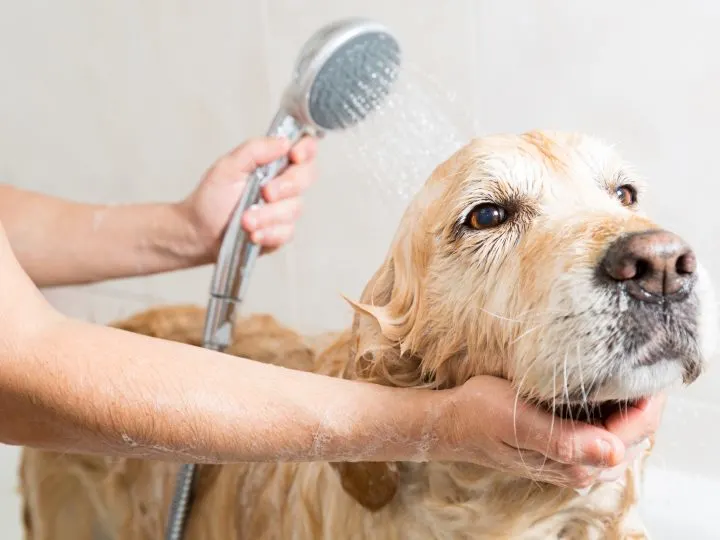Owners of Newfies are no strangers to shedding.
Even though they only blow their coat twice a year, this breed sheds 24 hours a day, 365 days of the year.
Newfie hair is our glitter and we’re ok with that, however, sometimes we all need to find a way to manage the amount of hair that we live in.
Shedding is a totally natural process for dogs and they all do it, but some dogs do it better and in larger amounts.
The amount of fur a dog sheds depends on a few things like the breed of the dog, the time of the year, their general health, and what type of coat they have; single or double coat.
Dogs that have a double coat will tend to shed more than dogs with a single layer coat.
Some dog breeds that are known for having thick, double coats that shed all the time are the Akita, Bernese Moutain Dog, Siberian Husky, Newfoundland, Samoyed, Lab, Golden Retriever, Chow Chow, Great Pyrenees, St. Bernard, Cardigan Welsh Corgi and German Shepherd. (+many more!)

Can I Prevent My Dog from Shedding?
You can’t keep a dog from shedding, but you can either choose a breed of a dog that doesn’t shed as much or manage their shedding with proper grooming and nutrition.
There are no dogs that don’t shed but there are low-shedding dogs that produce less dander.
How Can I Manage My Dog’s Shedding?
Some owners will opt to shave their dog to try and stop the shedding but the coat will eventually grow back.
Shaving a dog’s coat should only be done for medical reasons, not for the owner’s convenience, so instead of clipping your dog’s coat down to the skin there are several steps you can make to manage their hair:
Brush your dog’s coat regularly.
While every dog’s coat will be different from the next it’s still important to brush or comb their coat on a regular basis.
Some double coat breeds need to be brushed daily whereas dogs with a short coat can get away with a weekly brush.

Since brushes are designed to manage different types of coat, it’s important to choose the right brush for your dog’s fur:
- Bristle brushes work well for almost every coat type-both long and short. For a longer coat, try to stick with long bristles. For dogs with shorter hair, pick a brush with stiff bristles.
- Wire-pin brushes work well for dogs with woolly or curly coats that can get tangled often.
- Slicker brushes are great for dogs with thick dense coats.
- Rake brushes are a must-have for dogs that have a double coat, especially when they are blowing their coat
- Combs work well for any dog and they help remove dander, dead skin, and old hair. They’re also used for line-combing double-coated breeds.
Shedding tools are great to use when your dog sheds heavily twice a year or every day of the year.
Shedding tools are brushes with steel tines and they work well to remove a dog’s undercoat before it ends up all over your house.
Some well-known shedding tools are the Furminator and Mars Coat King.
The Mars Coat King is great for thinning out a thick coat.
Bathe your dog regularly.
Giving your dog a bath not only keeps their fur and skin clean but it also helps to remove loose and dead hair.

Blow drying your dog after a bath with a high-velocity dog dryer will remove even more loose hair and the nice thing about a dog dryer is that you can use it on a dry coat in between baths.
Owners with thick-coated dogs swear by this technique and I do often with my Newfies.
Feed your dog a healthy diet.
Just like with people, when a dog is eating a healthy diet and getting good nutrition, their hair is healthier too.
Dogs that are lacking nutrition will often have dry, brittle coats.

Talk to your veterinarian about adding Omega 3’s to your dog’s diet.
Always make sure that your dog has fresh water available so that they don’t become dehydrated.
Medical Conditions That Can Make Dogs Shed More
For some dog breeds like the Newfoundland, shedding is what they do best!However, sometimes excessive shedding can be the sign of a health issue such as:
- Parasites like fleas, mites, or ticks
- Skin infections
- Fungal infections
- Allergies (food or environmental)
- Hot spots
- Topical irritants
- Immune diseases
- Kidney disease
- Liver conditions
- Thyroid or adrenal issues
- Side-effects from medication
- Stree or anxiety
- Cancer
Dogs Shed
Dogs shed.
Period.
It comes with the territory of owning one.
If you take the time to care for your dog’s coat you can reduce some of the excessive dog hair floating around your home, plus, you get to spend some extra time bonding with your very best friend.